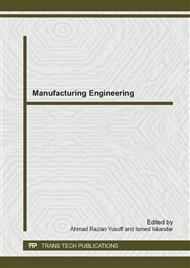[1]
R. Rajesh, M.D. Anand, The optimization of the electro-discharge machining process using response surface methodology and genetic algorithms, International Conference on Modelling, Optimization and Computing. 38 (2012) 3941-3950.
DOI: 10.1016/j.proeng.2012.06.451
Google Scholar
[2]
S. Assarzadeh, M. Ghoreishi, Statistical modeling and optimization of process parameters in electro-discharge machining of cobalt-bonded tungsten carbide composite (WC/6%Co), The Seventeenth CIRP Conference on Electro Physical and Chemical Machining (ISEM). 6 (2013).
DOI: 10.1016/j.procir.2013.03.099
Google Scholar
[3]
M.A. Abbas, G.S. Darius, Md. Fuad Bahari, A review on current research trends in electrical discharge machining (EDM), Int. J. Mach. Tools Manuf. 47(2007) 1214-1228.
DOI: 10.1016/j.ijmachtools.2006.08.026
Google Scholar
[4]
K.H. Ho, S.T. Newman, State of the art electrical discharge machining (EDM) Int. J. Mach. Tools Manuf, 43 (2003) 1287-1300.
DOI: 10.1016/s0890-6955(03)00162-7
Google Scholar
[5]
J.P. Davim, Machining of Complex Sculptured Surfaces, Springer London, New York, (2012).
Google Scholar
[6]
E. Kannatey, J.R. Asibu, Principles of Laser Materials Processing, John Wiley & Sons, New Jersey, (2009).
Google Scholar
[7]
Y. Jamal, A. Sheikh, Machining of Polymer Matrix Composites, Springer, New York, (2009).
Google Scholar
[8]
S. Put, J. Vleugels, O. Van Der Biest, C.S. Trueman, J. Huddleston, Die sink electro discharge machining of zirconia based composites, Br. Ceram. Trans. 100 (2001) 207-213.
DOI: 10.1179/096797801681477
Google Scholar
[9]
K. Liu, J. Peirs, E. Ferraris, B. Lauwers, D. Reynaerts, Micro Electrical Discharge Machining of Si3N4-based Ceramic Composites, Multi-Material Micro Manufacture. (2008).
Google Scholar
[10]
Forster, K. Klein, U. Laudien, S. Settegast, and R. Subramanian, U.S. Patent 2010/0038344 A1. (2010).
Google Scholar
[11]
S.H. Aghdeab, A.A. Abdul Wahab, Study the effect of electrical current on average surface roughness of borosilicate glass at EDM machining and comparison using MATLAB program, Eng. & Tech. Journal. 29 (2011).
Google Scholar
[12]
R. Karthikeyan, P.R.L. Narayanan, R.S. Naagarazan, Mathematical modelling for electrical discharge machining of Aluminium-silicon carbide particulate composite, Material Processing Journal. 87(59-63).
DOI: 10.1016/s0924-0136(98)00332-x
Google Scholar
[13]
A.A. Majdi, M. Alexis, A. Faiz, Non-conventional Machining of Aluminium Metal Matrix Composite. 5-7 (2009).
Google Scholar
[14]
A. Curodeau, M. Richard, L. Frohn-Villeneuve, Molds surface finishing with new EDM process in air with thermoplastic composite electrodes, Material Processing Journal. 149 (2004). 278-283.
DOI: 10.1016/j.jmatprotec.2003.10.040
Google Scholar
[15]
K.L. Senthil Kumar, R. Sivasubramaniam, K. Kalaiselvan, Selection of optimum parameters in non conventional machining of metal matrix composite. Portugaliae Electrochimica Acta. 27 (2009) 477-486.
DOI: 10.4152/pea.200904477
Google Scholar
[16]
C. Velmurugan, R. Subramaniam, Experimental investigation on machining characteristic of Al 6061 hybrid metal matrix composite processed by electrical discharge machining. 3(2012) 87-101.
DOI: 10.4314/ijest.v3i8.7
Google Scholar
[17]
Y. Guu, H. Hocheng, N. Tai, S. Liu, Effect of Electrical Discharge Machining on the characteristic of carbon fiber reinforced carbon composites. Material Science. 6 (2001) 2037-(2043).
Google Scholar
[18]
P. Narender Singh, K. Raghukandan, B.C. Pai, Optimization by grey relation analysis of EDM parameters on machining Al-10%SiCp composite. Material Processing Journal. (2004) 1658-1661.
DOI: 10.1016/j.jmatprotec.2004.04.322
Google Scholar
[19]
Jameson, Electrical Discharge Machining, United States of America, Society of Manufacturing Engineers, (2001).
Google Scholar


